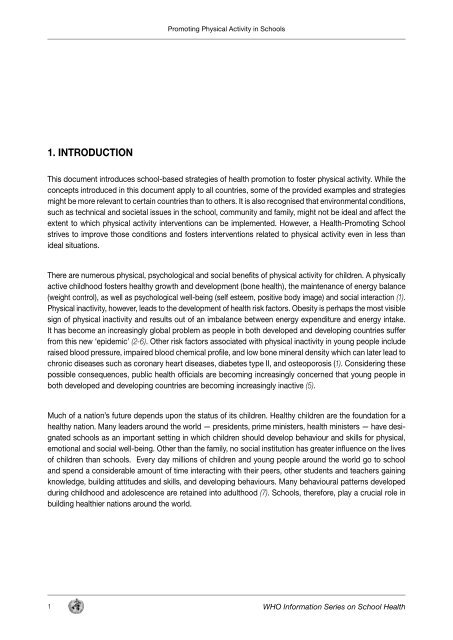WHO INFORMATION SERIES ON SCHOOL HEALTH ... - PAHO/WHO
WHO INFORMATION SERIES ON SCHOOL HEALTH ... - PAHO/WHO
WHO INFORMATION SERIES ON SCHOOL HEALTH ... - PAHO/WHO
You also want an ePaper? Increase the reach of your titles
YUMPU automatically turns print PDFs into web optimized ePapers that Google loves.
1. INTRODUCTI<strong>ON</strong><br />
1<br />
Promoting Physical Activity in Schools<br />
This document introduces school-based strategies of health promotion to foster physical activity. While the<br />
concepts introduced in this document apply to all countries, some of the provided examples and strategies<br />
might be more relevant to certain countries than to others. It is also recognised that environmental conditions,<br />
such as technical and societal issues in the school, community and family, might not be ideal and affect the<br />
extent to which physical activity interventions can be implemented. However, a Health-Promoting School<br />
strives to improve those conditions and fosters interventions related to physical activity even in less than<br />
ideal situations.<br />
There are numerous physical, psychological and social benefits of physical activity for children. A physically<br />
active childhood fosters healthy growth and development (bone health), the maintenance of energy balance<br />
(weight control), as well as psychological well-being (self esteem, positive body image) and social interaction (1).<br />
Physical inactivity, however, leads to the development of health risk factors. Obesity is perhaps the most visible<br />
sign of physical inactivity and results out of an imbalance between energy expenditure and energy intake.<br />
It has become an increasingly global problem as people in both developed and developing countries suffer<br />
from this new ‘epidemic’ (2-6). Other risk factors associated with physical inactivity in young people include<br />
raised blood pressure, impaired blood chemical profile, and low bone mineral density which can later lead to<br />
chronic diseases such as coronary heart diseases, diabetes type II, and osteoporosis (1). Considering these<br />
possible consequences, public health officials are becoming increasingly concerned that young people in<br />
both developed and developing countries are becoming increasingly inactive (5).<br />
Much of a nation’s future depends upon the status of its children. Healthy children are the foundation for a<br />
healthy nation. Many leaders around the world — presidents, prime ministers, health ministers — have designated<br />
schools as an important setting in which children should develop behaviour and skills for physical,<br />
emotional and social well-being. Other than the family, no social institution has greater influence on the lives<br />
of children than schools. Every day millions of children and young people around the world go to school<br />
and spend a considerable amount of time interacting with their peers, other students and teachers gaining<br />
knowledge, building attitudes and skills, and developing behaviours. Many behavioural patterns developed<br />
during childhood and adolescence are retained into adulthood (7). Schools, therefore, play a crucial role in<br />
building healthier nations around the world.<br />
<strong>WHO</strong> Information Series on School Health

















